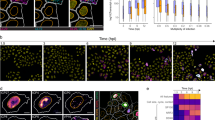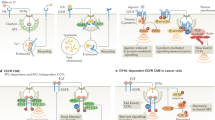Abstract
Single-cell heterogeneity in cell populations arises from a combination of intrinsic and extrinsic factors1,2,3. This heterogeneity has been measured for gene transcription, phosphorylation, cell morphology and drug perturbations, and used to explain various aspects of cellular physiology4,5,6. In all cases, however, the causes of heterogeneity were not studied. Here we analyse, for the first time, the heterogeneous patterns of related cellular activities, namely virus infection, endocytosis and membrane lipid composition in adherent human cells. We reveal correlations with specific cellular states that are defined by the population context of a cell, and we derive probabilistic models that can explain and predict most cellular heterogeneity of these activities, solely on the basis of each cell’s population context. We find that accounting for population-determined heterogeneity is essential for interpreting differences between the activity levels of cell populations. Finally, we reveal that synergy between two molecular components, focal adhesion kinase and the sphingolipid GM1, enhances the population-determined pattern of simian virus 40 (SV40) infection. Our findings provide an explanation for the origin of heterogeneity patterns of cellular activities in adherent cell populations.
This is a preview of subscription content, access via your institution
Access options
Subscribe to this journal
Receive 51 print issues and online access
$199.00 per year
only $3.90 per issue
Buy this article
- Purchase on Springer Link
- Instant access to full article PDF
Prices may be subject to local taxes which are calculated during checkout



Similar content being viewed by others
References
Elowitz, M. B., Levine, A. J., Siggia, E. D. & Swain, P. S. Stochastic gene expression in a single cell. Science 297, 1183–1186 (2002)
Maheshri, N. & O’Shea, E. K. Living with noisy genes: how cells function reliably with inherent variability in gene expression. Annu. Rev. Biophys. Biomol. Struct. 36, 413–434 (2007)
Raj, A. & van Oudenaarden, A. Nature, nurture, or chance: stochastic gene expression and its consequences. Cell 135, 216–226 (2008)
Sigal, A. et al. Variability and memory of protein levels in human cells. Nature 444, 643–646 (2006)
Sachs, K., Perez, O., Pe’er, D., Lauffenburger, D. A. & Nolan, G. P. Causal protein-signaling networks derived from multiparameter single-cell data. Science 308, 523–529 (2005)
Keren, K. et al. Mechanism of shape determination in motile cells. Nature 453, 475–480 (2008)
Liberali, P., Ramo, P. & Pelkmans, L. Protein kinases: starting a molecular systems view of endocytosis. Annu. Rev. Cell Dev. Biol. 24, 501–523 (2008)
Pelkmans, L. et al. Genome-wide analysis of human kinases in clathrin- and caveolae/raft-mediated endocytosis. Nature 436, 78–86 (2005)
Wilkinson, D. J. Stochastic modelling for quantitative description of heterogeneous biological systems. Nature Rev. Genet. 10, 122–133 (2009)
Eifart, P. et al. Role of endocytosis and low pH in murine hepatitis virus strain A59 cell entry. J. Virol. 81, 10758–10768 (2007)
Neu, U., Woellner, K., Gauglitz, G. & Stehle, T. Structural basis of GM1 ganglioside recognition by simian virus 40. Proc. Natl Acad. Sci. USA 105, 5219–5224 (2008)
Pelkmans, L. Secrets of caveolae- and lipid raft-mediated endocytosis revealed by mammalian viruses. Biochim. Biophys. Acta 1746, 295–304 (2005)
Conner, S. D. & Schmid, S. L. Regulated portals of entry into the cell. Nature 422, 37–44 (2003)
Mayor, S. & Pagano, R. E. Pathways of clathrin-independent endocytosis. Nature Rev. Mol. Cell Biol. 8, 603–612 (2007)
Holmgren, J., Lonnroth, I. & Svennerholm, L. Tissue receptor for cholera exotoxin: postulated structure from studies with GM1 ganglioside and related glycolipids. Infect. Immun. 8, 208–214 (1973)
Sacher, R., Stergiou, L. & Pelkmans, L. Lessons from genetics: interpreting complex phenotypes in RNAi screens. Curr. Opin. Cell Biol. 20, 483–489 (2008)
Eagle, H. & Levine, E. M. Growth regulatory effects of cellular interaction. Nature 213, 1102–1106 (1967)
Castor, L. N. Flattening, movement and control of division of epithelial-like cells. J. Cell. Physiol. 75, 57–64 (1970)
Slack, M. D., Martinez, E. D., Wu, L. F. & Altschuler, S. J. Characterizing heterogeneous cellular responses to perturbations. Proc. Natl Acad. Sci. USA 105, 19306–19311 (2008)
Nachman, I., Regev, A. & Ramanathan, S. Dissecting timing variability in yeast meiosis. Cell 131, 544–556 (2007)
St-Pierre, F. & Endy, D. Determination of cell fate selection during phage lambda infection. Proc. Natl Acad. Sci. USA 105, 20705–20710 (2008)
Ben-Jacob, E., Cohen, I. & Gutnick, D. L. Cooperative organization of bacterial colonies: from genotype to morphotype. Annu. Rev. Microbiol. 52, 779–806 (1998)
Lopez, S. & Arias, C. F. Multistep entry of rotavirus into cells: a Versaillesque dance. Trends Microbiol. 12, 271–278 (2004)
Geiger, B., Spatz, J. P. & Bershadsky, A. D. Environmental sensing through focal adhesions. Nature Rev. Mol. Cell Biol. 10, 21–33 (2009)
Neumann, A. K., Thompson, N. L. & Jacobson, K. Distribution and lateral mobility of DC-SIGN on immature dendritic cells–implications for pathogen uptake. J. Cell Sci. 121, 634–643 (2008)
Iwabuchi, K. et al. Reconstitution of membranes simulating “glycosignaling domain” and their susceptibility to Lyso-GM3. J. Biol. Chem. 275, 15174–15181 (2000)
Palazzo, A. F., Eng, C. H., Schlaepfer, D. D., Marcantonio, E. E. & Gundersen, G. G. Localized stabilization of microtubules by integrin- and FAK-facilitated Rho signaling. Science 303, 836–839 (2004)
Newman, J. R. & Weissman, J. S. Systems biology: many things from one. Nature 444, 561–562 (2006)
Carpenter, A. E. et al. CellProfiler: image analysis software for identifying and quantifying cell phenotypes. Genome Biol. 7, R100 (2006)
Acknowledgements
We acknowledge H. Verheije and L. Burleigh for providing images of MHV and dengue virus infection, G. Jurisic for providing primary cells and help with experiments, and all members of the laboratory for comments on the manuscript. P.R. is supported by the European Molecular Biology Organisation and the Human Frontiers Science Program, E.-M.D. by Oncosuisse and P.L. by the Federation of European Biochemical Societies. L.P. is supported by the ETH Zürich, SystemsX.ch, the Swiss National Science Foundation and the European Union.
Author Contributions L.P. supervised and conceived the project. R.S., B.S., E.-M.D. and P.L. performed experiments, B.S. and P.R. developed computational image analysis methods, B.S. performed all computational image analysis, B.S. and P.R. conceived the statistical analysis methods, B.S. performed all statistical analysis, L.P. and B.S. wrote the manuscript.
Author information
Authors and Affiliations
Corresponding author
Supplementary information
Supplementary Information
This file contains Supplementary Figures 1-10 with Legends, Supplementary Movie 1 Legend, Supplementary Methods, Supplementary Data, Supplementary Table 1 and Supplementary References. (PDF 6784 kb)
Supplementary Movie 1
This movie file shows that population properties are determined during growth of adherent human cells - see file s1 for full Legend. (MOV 9511 kb)
Rights and permissions
About this article
Cite this article
Snijder, B., Sacher, R., Rämö, P. et al. Population context determines cell-to-cell variability in endocytosis and virus infection. Nature 461, 520–523 (2009). https://doi.org/10.1038/nature08282
Received:
Accepted:
Published:
Issue Date:
DOI: https://doi.org/10.1038/nature08282
This article is cited by
-
Cellular state landscape and herpes simplex virus type 1 infection progression are connected
Nature Communications (2023)
-
Research on GGT-responsive drug carrier with active transport effect
Nano Research (2023)
-
Deciphering variations in the endocytic uptake of a cell-penetrating peptide: the crucial role of cell culture protocols
Cytotechnology (2023)
-
Relating individual cell division events to single-cell ERK and Akt activity time courses
Scientific Reports (2022)
-
In plaque-mass spectrometry imaging of a bloom-forming alga during viral infection reveals a metabolic shift towards odd-chain fatty acid lipids
Nature Microbiology (2019)
Comments
By submitting a comment you agree to abide by our Terms and Community Guidelines. If you find something abusive or that does not comply with our terms or guidelines please flag it as inappropriate.



